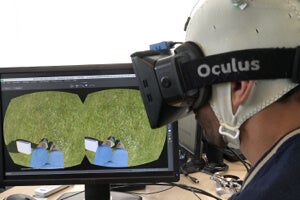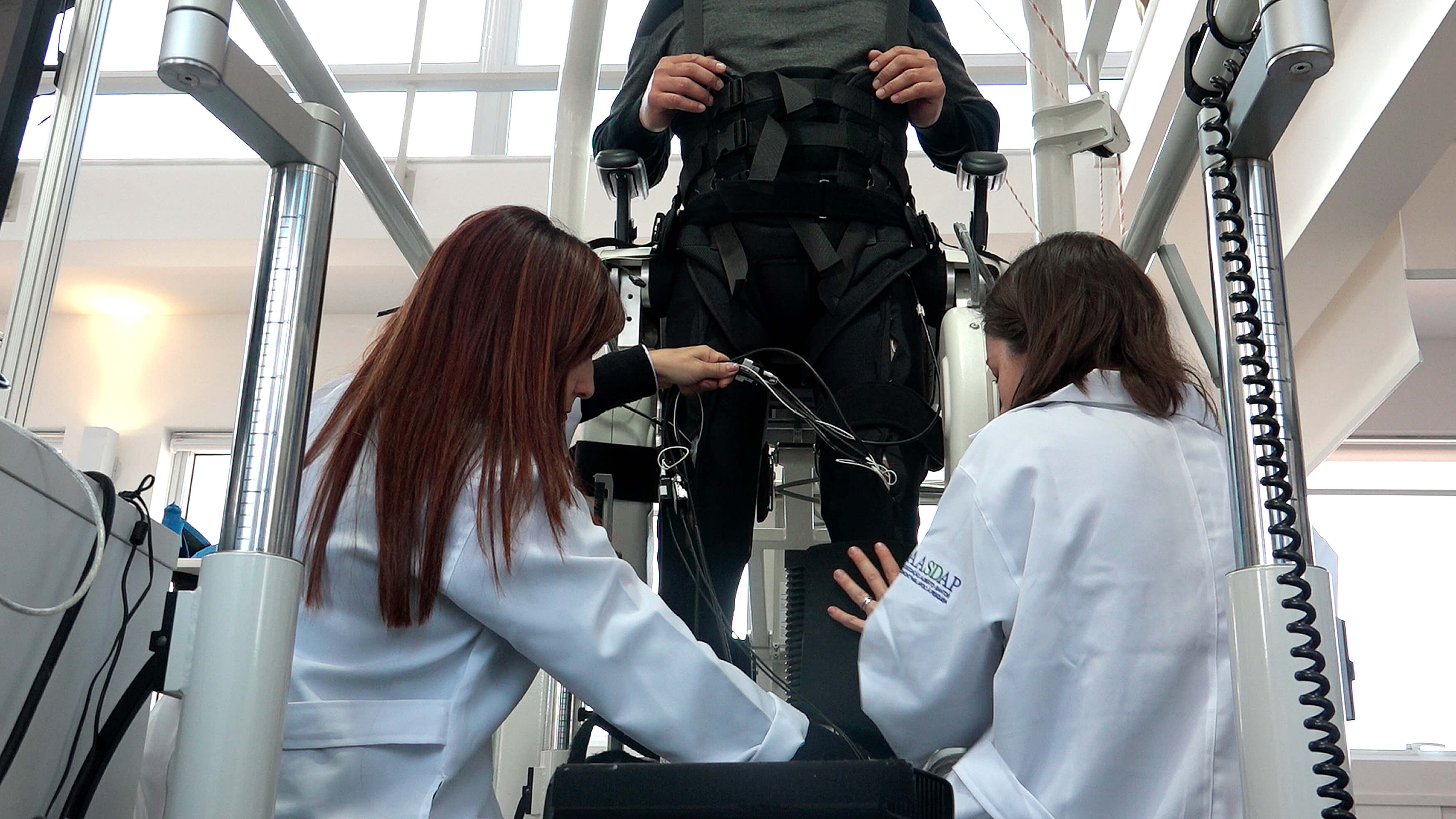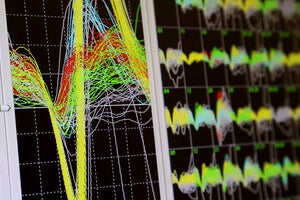Paralysis Partially Reversed With Virtual Reality Tech in Surprising New Study

Share
On June 12th, 2014, the world watched in awe as a young paraplegic kicked off the World Cup in Brazil with the help of a robotic exoskeleton controlled by his brain.
Now, the team behind the miraculous feat — the Walk Again Project — is back with an even more astonishing report. With a year of intense brain training, eight paraplegics regained partial sensation and voluntary control of their paralyzed body areas, despite having spinal cord injuries that were previously diagnosed as irreversible.
One participant, a 32-year-old woman, was even able to move her legs in a stepping motion with her body weight suspended by a harness. Prior to the therapy, she had been paralyzed for 13 years.
The study, led by Duke University superstar neuroengineer Dr. Miguel Nicolelis, was published last week in Scientific Reports.
Up until now, no clinical study in patients with severe spinal cord injuries has ever reported any improvement in their lost sensory and motor abilities. Even Nicolelis was shocked.
"We couldn't have predicted this surprising clinical outcome when we began the project,” he says in a press release, "until now, nobody has seen recovery of these functions in a patient so many years after being diagnosed with complete paralysis."
High-tech rehab
The star of the training regime is a brain-machine interface (BMI) system coupled to virtual reality and two robotic walking systems.
BMIs are Nicolelis’ bread-and-butter. Previously, his team used similar interfaces in monkeys, allowing them to control robotic limbs, computer avatars and drive around electrical wheelchairs using just their thought.
As cool as that sounds, however, a lot of these previous systems were invasive — that is, they relied on electrodes directly implanted into the monkeys’ brains to record brain activity, obviously not a great selling point for human use.

Image credit: AASDAP/Duke University
The new study eschewed brain surgery, instead using an EEG cap embedded with multiple electrodes as the recording component of the BMI. Although EEG is not as sensitive as implanted electrodes at capturing flickers of neural activity, it’s good enough to monitor big waves of activation, like those produced when we move.
The caps were tightly fitted over the patients’ motor brain regions to intercept signals, which were then used to command virtual avatars and robotic exoskeletons.
In the first stage of the regime, the patients donned an Oculus Rift headset and were transported into a game in which they controlled a soccer player standing in the middle of a stadium. They were told to picture themselves as the 3D avatar and try to move it around by imagining the movements in their own bodies. The patients also wore a “tactile shirt” that covered their forearms, which lightly vibrated every time the avatar’s feet touched the ground.
“The tactile feedback is synchronized and the patient’s brain creates a feeling that they are walking by themselves, not with the assistance of devices. It induces an illusion that they are feeling and moving their legs,” says Nicolelis in a press release.
It seemed to work: after training with virtual reality, the patients were eventually able to walk with the help of brain-controlled robotic exoskeletons in just a short 12 months. That’s a feat in-and-of-itself, but the real surprise was this: somehow, the training had reawakened the patient’s slumbering nervous system, spurring the brain to regain control of their paralyzed body parts.

Image credit: AASDAP/Duke University
All the patients showed improvements, regaining some voluntary control over muscles below their spinal cord injury — muscles closest to the injury site experienced the best improvement. They also progressed from completely unable to feel anything to experiencing light touches, pain and pressure, although their paralyzed body parts still couldn’t sense temperature. What’s more, their bowels and bladder functions also improved, suggesting that the nerves connecting spinal cord to internal organs had also healed to an extent.
This reduces the patients’ reliance on laxatives and catheters, which lowers their risk of serious infections that are a leading cause of death in patients with chronic paralysis, explains Nicolelis.
Overall, the improvements were so dramatic that half of the patients’ diagnosis were happily reclassified from complete to incomplete paraplegia.
Be Part of the Future
Sign up to receive top stories about groundbreaking technologies and visionary thinkers from SingularityHub.


Neuro rebirth
The team originally pegged their regime as assistive instead of rehabilitative, so the results were a welcome surprise. Why the training works so well, however, is still a mystery, though the team has some ideas.
When people become paralyzed, brain regions that represent the lost body parts are slowly reprogrammed to perform other functions — a sort of “use it or lose it.” Researchers can measure this by reading brain waves with EEG. And over the course of training, the participants’ EEG pattern clearly shifted.

Image credit: AASDAP/Duke University
“We began to see signs of plasticity in their cortical function,” says Nicolelis. “Our interpretation of these changes is that we were documenting the reassertion of a representation in the patient’ brains of the lower limbs and their movement.” In other words, the brain realized that the “lost” body parts were back online, and established new neural networks to regain control.
This reawakening of the central regulator, combined with muscle movement, may have propelled nerves in the spinal cord back into action.
Previous studies found that up to 80% of patients with complete paralysis still retain some nerve function past the injury sites. The nerves often lay dormant for years like abandoned cables, waiting for signals going from the cortex to the muscles to put them back in action.
We think that the training induced spinal plasticity because of the combined use of BMIs with virtual reality, physical moment and tactile feedback, says Nicolelis. When patients are walking upright again after many years, they excite receptors in their muscles, tendons and joints, which send electrical signals to the spinal cord prompting it to adapt accordingly, speculates Nicolelis.
More research is needed to validate these ideas.
Next steps
Nearly all of the participants in this study have continued their rehabilitation, and the team plans to publish an update on their additional recovery in the next year or so. They also plan to try their regime on patients who suffered more recent spinal cord injuries, to see if they experience better or faster recovery.
The team also envisions a future where brain training and stem cell injections are used together to regrow and rekindle nerves to the point of a full recovery.
“Currently, once people with spinal injuries receive a diagnosis of complete paralysis, rehabilitation consist mainly of adapting them to a wheelchair,” says Nicolelis. “We believe that our results with this long-term, sustained brain-machine interface training can be not only critical itself in triggering recovery in our patients, but it can also serve as an important motivator for spinal cord patients worldwide.”
Image and video credit:AASDAP/Duke University
Dr. Shelly Xuelai Fan is a neuroscientist-turned-science-writer. She's fascinated with research about the brain, AI, longevity, biotech, and especially their intersection. As a digital nomad, she enjoys exploring new cultures, local foods, and the great outdoors.
Related Articles

AI Can Now Design Proteins and DNA. Scientists Warn We Need Biosecurity Rules Before It’s Too Late.

Kids With Spinal Muscular Atrophy Show Dramatic Improvement With FDA-Approved Gene Therapy

These Were Our Favorite Tech Stories From Around the Web in 2025
What we’re reading